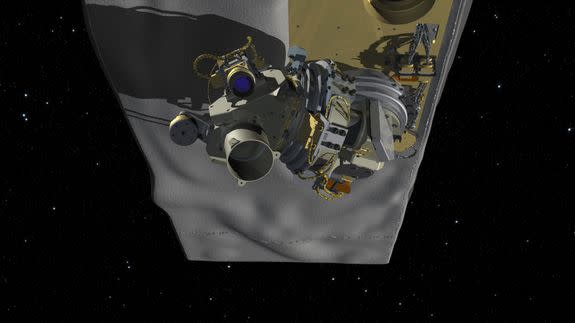SpaceX just blasted a critical NASA instrument into space

NASA's carbon-detecting sleuth has left Earth.
SpaceX launched the Orbiting Carbon Observatory-3 (OCO-3) to the International Space Station (ISS) at 2:48 a.m. ET on Saturday morning aboard the company's dependable Falcon 9 rocket. After NASA's cargo load arrives at the ISS, astronauts will use a long robotic arm to attach the refrigerator-sized instrument to the side of the earth-orbiting station.
OCO-3 will peer down on Earth, keeping tabs on the planet's amassing carbon dioxide emissions, which are now at their highest levels in millions of years.
"Carbon dioxide is the most important gas humans are emitting into the atmosphere," Annmarie Eldering, the project scientist for OCO-3 at NASA's Jet Propulsion Laboratory, told Mashable in February. "Understanding how it will play out in the future is critical."
Liftoff! https://t.co/gtC39uBC7z pic.twitter.com/IaHMvakoX7
— SpaceX (@SpaceX) May 4, 2019
After the SpaceX rocket lifted into space, the booster — the bottom portion of the rocket containing nine powerful engines — returned to Earth. It successfully landed on a drone ship in the Atlantic Ocean.
SpaceX now regularly lands its rockets on both drone ships and land. It's a fundamental part of the spaceflight company's business model — reusing expensive rockets rather than letting them crash into the ocean. Earlier this month, SpaceX impressively landed three boosters after its massive Falcon Heavy rocket (which consists of three rockets strapped together) launched an Arab communications satellite into Earth's orbit.
SEE ALSO: We're probably not going to hit the world's most important climate goal
NASA had slated the launch for late April, but asked SpaceX to delay it until the space agency could fix a power distribution problem on the ISS — which is currently home to six astronauts and cosmonauts.
OCO-3 — which can detect carbon dioxide concentrations on Earth within 1 part per million — almost didn't make it into space. In both 2017 and 2018 the Trump administration (which is candidly opposed to climate science) sought to eliminate the earth-monitoring instruments.
"We heard OCO-3 was not going to go," Britton Stephens, a senior scientist at the National Center for Atmospheric Research who works on the OCO-3 science team, said in an interview. "There've been lots of ups and downs in the project."
But advocacy from NASA leaders and congressional support kept OCO-3 alive. Now it's in space.

Image: nasa / JPL / Caltech
OCO-3 will follow in the footsteps of OCO-2 by continuing to precisely monitor the places on Earth (cities and countries) that emit bounties of carbon dioxide, and those areas that suck or absorb CO2 out of the atmosphere (oceans and forests). The growing log of measurements makes OCO-3 especially valuable to scientists, who need long-term data to follow trends and discover novel data.
"The longer the records grow, the more important they become," said Pontus Olofsson, an associate research professor at Boston University who uses satellites to research Earth's carbon cycle. "It's like an exponential increase in importance."
These measurements are all the more salient today, as modern civilization attempts to slash its heat-trapping carbon emissions and curb the planet's accelerating warming trend. As of 2019, the prospect of limiting warming to 1.5 degrees Celsius (or 2.7 degrees Fahrenheit) above 19th-century levels — which would avoid the worst consequences of climate change — looks dismal.
OCO-3 will be watching.
WATCH: Ever wonder how the universe might end?


